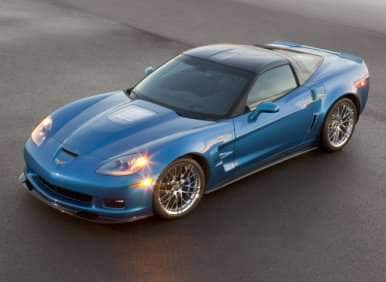Recent Articles
Popular Makes
Body Types
Chevrolet Corvette Used Car Buying Guide
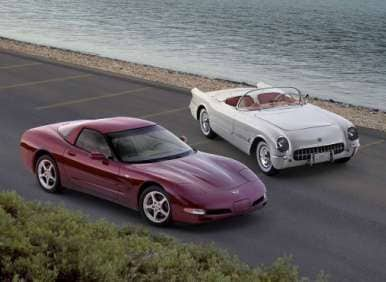
Few cars have achieved the iconic status of Chevrolet’s Corvette.
Introduced in 1953 as a concept car at the GM Motorama in New York, only 300 of the fiberglass roadsters were built that first year. However, they were hand built, giving them two distinctions; (a) being the first Corvette and (b) being the only handmade iteration of the car ever sold to the general public by the factory.
Seizing the public’s imagination the way few other cars have done before or since, the Corvette is intricately woven into the fabric of America. Prominently featured in parades, at fairs, at football and baseball games, and anyplace else where large numbers of Americans gather where cars could be part of the festivities, the Chevrolet Corvette is arguably America’s only true sports car.
The early astronauts also favored Corvettes. Pulling up to NASA headquarters in Florida in the 1960’s would routinely reveal a brace of the shark-nosed two seaters. Jim Rathmann, the former Melbourne, Fla. Chevrolet dealer (and Indy 500 winner) convinced then-GM president Ed Cole to establish a special deal for astronauts. Under the program, astronauts could purchase two cars from Rathmann at a discount. Most chose a wagon or a sedan for their wives and a Corvette for themselves. In those days, astronauts were culled from the ranks of the American military’s test pilots, so by definition these were guys who loved speed. And no other American car said speed the way the Corvette did.
There have been six generations of the Corvette produced since 1953.
The generally agreed upon designation for each is its numerical place in succession, preceded by the letter “C”. Thus the first generation of the Chevrolet is C1 and the current generation is C6. The C7 Chevrolet Corvette is expected to debut in the fall of 2013.
This buyer’s guide picks up with Corvette C5, introduced in 1997.
Chevrolet Corvette: 1997 – 2004
The C5 Corvette marked the model’s serious return to extremely high performance. After languishing from roughly 1975 to 1991 while GM figured out how to build high performance engines capable of meeting the era’s new strict emissions standards, the C4 Corvette of 1992 was the first model in some 16 years to have a 300 horsepower engine as standard equipment.
There were a few optional engines in between that eclipsed the 300 horsepower mark, most notably the 1991 Corvette ZR-1 (345 horsepower) and the 1991 twin-turbo model (450 horsepower); but your basic garden variety Corvettes barely cleared 250 horsepower in those days. This all changed with the introduction of the C5, whose third generation of the small block V8 delivered 345 horsepower, 350 ft-lbs of torque and remarkably, 28 miles per gallon on the highway.
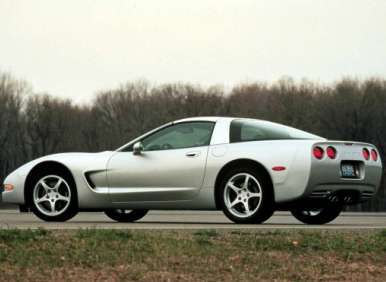
Chevrolet Corvette: 1997
For MY’97 only one trim level was available, the Base Corvette Coupe.
Powered by a 5.7-liter V8 and fitted with the buyer’s choice of a four-speed automatic transmission or a six-speed manual transmission, the 1997 Corvette was—up to that point—the fastest, best handling standard Corvette ever. Traction control was standard equipment, as was four-wheel disc brakes with ABS. The C5 Corvette ran a staggered tire and wheel setup with the front alloys measuring seventeen inches and the rears measuring eighteen. These were mounted on a fully independent, height adjustable suspension system.
The body was still made mostly of fiberglass, but was alloyed with resins and polymers to make it stronger and smoother. Steel side rails were incorporated to improve rigidity and the windshield frame was made of aluminum. Balsa wood was used in the floor to defeat vibration and road noise, in addition to stiffening the structure.
Standard features included power adjustable heated outside rear view mirrors, a keyless entry system, a limited-slip differential, and a solid, removable targa-style roof. There were airbags for the driver and passenger, an alarm system, leather upholstery and a power-actuated adjustable driver’s seat. Cruise control, power steering, an inside trunk release, and leather steering wheel trim were standard features as well. Further, the C5 Corvette featured air conditioning, power windows and door locks, daytime running lights and a cassette-based audio system.
The options list contained a CD changer, electronic suspension control, fog lights, a removable glass top, sport seats, memory for the driver’s seat, power operation for the passenger’s seat, and automatic climate control.
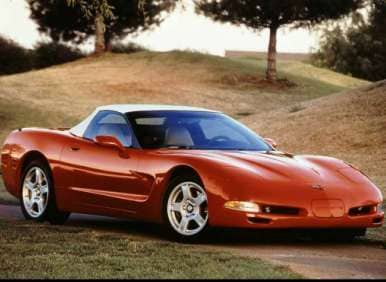
Chevrolet Corvette: 1998
The C5 Corvette convertible debuted with a manual-folding top, which folded away beneath a hard tonneau cover. The C5 was designed as a convertible in the first place, so performance, ride and handling were on par with the coupe.
Magnesium wheels were added as an option for the coupe.
1999
Corvette Hardtop (sans removable targa roof), with less weight and a lower price than the “Base” Corvette was introduced. Corvette Hardtop made do without the automatic transmission and power seats for weight savings of just over 90 pounds.
Stability control and a head-up display were added to the list of options for the base model and the convertible.
Magnesium wheels were added to the convertible’s options list.
2000
The Z51 handling package fitted larger front and rear sway bars, a thin-spoke alloy wheel was introduced, the passenger door-lock cylinder was removed, the keyless entry system was improved, and a red interior was offered as an option. Also added was a Bose audio system as standard on the hardtop and convertible, but as an option on the coupe.
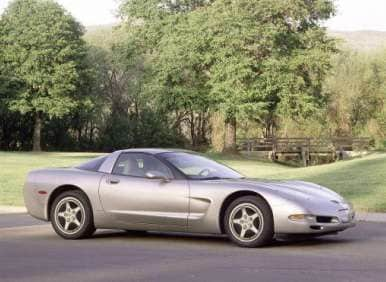
Chevrolet Corvette: 2001
The LS1 engine was reworked to produce more horsepower and torque, 350 and 360 respectively (the torque figure was 375 ft-lbs with the manual transmission). Active Handling Control was added as standard equipment to all models.
Corvette Z06 was introduced with a 385-horsepower LS6 V8 engine, capable of generating 385 ft-lbs of torque. In 2001, the Corvette Z06 became the lightest, fastest, and stiffest Corvette ever produced.
2002
For the 2002 model year, output of the LS6 was increased to 405 horsepower and 400 ft-lbs of torque for the Z06. The suspension system was reworked to keep pace, and a head-up system was installed so the Z06 driver could keep a vigilant eye on the road.
2003
Fog lights, power seats for the driver and passenger, and dual zone auto climate control were added to the standard equipment list for all 2003 Corvette models.
The 50th Anniversary Chevrolet Corvette was offered with deep red exterior paint and a beige leather interior treatment. The Corvette’s magnetic suspension system debuted on that car as standard equipment (it was an option for all the other 2003 models). Metallic particles were suspended in a special fluid in the shocks. When an electrical charge was applied to the shocks the particles would clump together magnetically and stiffen the shock absorber. A computer was programmed to “sense” body movement and “tell” the shocks when to stiffen.
Using this system, the Corvette got better handling, as the shocks reacted faster to the surface of the road over which the car was traveling.
2004
The last year of production of the C5 Corvette included a special Commemorative Edition, which paired the Anniversary Model’s beige interior with deep blue exterior paint. Commemorative Edition C5 Corvettes also wore a polished aluminum wheel. The Commemorative Z06 used a carbon fiber hood, and a specific wheel. It also wore a set of Le Mans racing stripes.
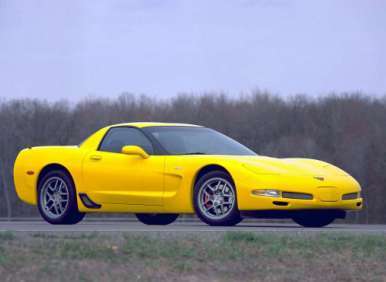
Chevrolet Corvette: 2005 – Current (2012)
The 2005 Chevrolet Corvette C6 represented a complete redesign in most respects. While the C6 featured a longer wheelbase, its overall dimensions were smaller in an attempt to make the car more palatable for European drivers as an export model.
While the basic chassis was an evolution of the C5’s, the geometry was reworked to improve ride and handling for the C6.
New engines for the Base models and the Z06 delivered more power and torque—but at the expense of fuel economy. The LS2 6.0-liter V8 in the Base models delivered 400 horsepower, 424 ft-lbs of torque and 26 miles per gallon on the highway. A six-speed manual transmission was standard for the C6 Corvette, while a six-speed automatic transmission was offered as an option.
Featuring an exposed set of headlights for the first time on a Corvette since 1962, the C6 also offered a choice of three suspension systems; the base double wishbone, one with Magnetic Ride Control, and a Z51 package with upgraded brakes, suspension components and transmission gearing.
The Corvette’s active handling system was capable of determining when the car was about to slide or skid and could apply braking or reduce engine power to help the driver maintain control of the car. The system featured a performance-driving mode, which allowed the driver to switch it off for track excursions.
In response to the thousands of words of criticism the C5 endured regarding the cheap plastic look of its interior, the product team at Chevrolet responsible for the Corvette made a concerted effort to improve the passenger compartment for the C6. In some ways they succeeded, though the Corvette still fell far short of its imported rivals in this regard.
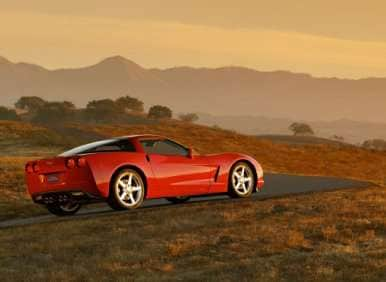
Chevrolet Corvette: 2005
The C6 Corvette debuted with a staggered set of eighteen and nineteen-inch painted alloy wheels wearing run-flat tires. Featuring a removable targa-style roof as did its predecessor, the Base C6 came with intermittent wipers and a rear window defogger as standard equipment. The convertible featured an optional power-folding top.
Other standard features included a six-way power adjustable seat for the driver, leather upholstery, remote power door locks, heated power adjustable exterior mirrors, one-touch operation for both power windows, cruise control, a center console with storage, cup holders, door pockets, and a remote trunk release inside the car.
Retained accessory power enabled the enjoyment of the radio after the Corvette’s engine was shut off, while the leather-trimmed tilt adjustable steering wheel controlled speed proportional power steering. Incoming air was filtered through the dual zone automatic climate control system and dual illuminated vanity mirrors were fitted into the sun visors.
Floor mats were included in the base price, as was an external temperature display and a seven-speaker audio system featuring an in-dash CD player with MP3 playback capability.
Traction control, stability control, electronic brake force distribution, and ventilated disc brakes were fitted, in addition to an alarm system, daytime running lights, an engine immobilizer, auto on and delayed off Xenon headlights, and a tire pressure monitoring system.
A DVD-based navigation system was optional for both the coupe and the convertible, while the coupe also offered an optional set of side airbags. Other options included a head-up display and a seven-speaker Bose audio system.
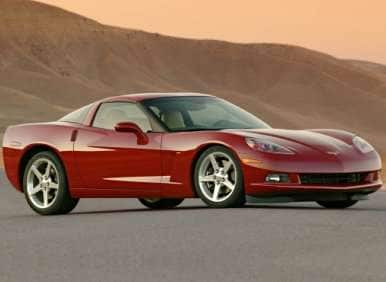
Chevrolet Corvette: 2006
A new six-speed manual transmission was fitted to the 2006 models, along with a smaller diameter steering wheel. The optional Bose audio system got satellite radio.
But best of all, the C6 Z06 went into production.
The C6 Z06 actually debuted late in 2005, as a 2006 model, with a 7.0-liter LS7 V8 capable of 505 horsepower and 470 ft-lbs of torque, making it the largest small-block V8 ever fitted to a factory production car by GM. The C6 Z06 was also the most powerful production Corvette ever at its introduction.
Equipped largely the same as the standard Corvettes in terms of comfort and convenience, the Z06 used an aluminum frame instead of the hydroformed steel found in standard Corvettes. It also wore wider tires and wheels, a stiffer suspension system and more powerful brakes.
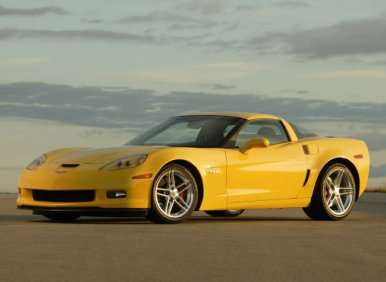
Chevrolet Corvette: 2007
For 2007, the Magnetic Ride Control option got a set of bigger cross-drilled brakes to go along with it. A special Indy Pace Car version of the convertible was offered with orange paint, gold stripes split-spoke wheels and special Indy 500 embroidery for the seats. A “Ron Fellows” version of the Z06 was offered to honor the American Le Mans series driver.
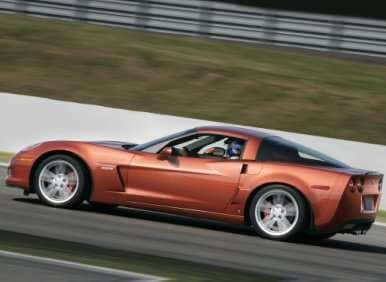
Chevrolet Corvette: 2008
The LS2 engine fitted to the Base Corvette models was replaced with an LS3 powerplant capable of 430 horsepower and 424 ft-lbs of torque. A special performance exhaust system was offered as an option, which upped power output to 436 horsepower and 428 ft-lbs.
OnStar made its debut in the Corvette as standard equipment for MY’08, along with satellite radio and electrochromatic auto-dimming mirrors. Steering and transmission were recalibrated to provide more refinement and the interior was upgraded a bit as well. A special 427 Limited Edition Z06 model was festooned with “427” graphics, a special paint job and a titanium grey interior.
That said, for 2008, the basic Corvette model lineup was coupe and convertible. Within the coupe category there were the Base, Z06, Indy, and “427” designations. The coupe category also included fixed-roof and targa-topped configurations.
Xenon headlamps, keyless entry and pushbutton start, a full set of power accessories (windows, seats and exterior mirrors), satellite radio, a CD player and an audio input jack, OnStar, auto-dimming mirrors, leather upholstery, and dual-zone automatic climate control were the highlights of the standard equipment list for both coupes and the convertible.
The Z06 used the more powerful V8, a lighter frame and larger wheels and tires. It also benefitted from a more stiffly tuned suspension system, more powerful brakes and Z06-specific sport seats.
Options for the standard coupes and the convertible included a two-tone leather interior treatment, which also specified leather covering the dash, center console and armrests. Other options included a navigation system, a transparent roof panel for the coupe, a head-up display, driver-seat memory and a seven-speaker Bose audio system.
On the mechanical front, Corvette’s product planners mandated the choices of Magnetic Ride Control or the Z51 performance and handling package. More than just a suspension tweak, the Z51 option added extra cooling capacity for the mechanicals, stiffer suspension calibrations, bigger brakes with cross-drilled rotors, specific tires, and shorter gearing for the six-speed manual transmission.
Equipment choices for the Z06 models were similar, save the transparent roof panel and of course, the suspension options.
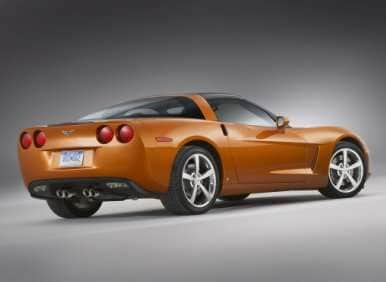
Chevrolet Corvette: 2009
Corvette ZR1 returned to the lineup producing 638 horsepower and 604 ft-lbs of torque from a hand-assembled supercharged 6.2-liter V8. To deal with the engine’s enhanced output, Corvette engineers specified a strengthened transmission, a staggered set of nineteen and twenty-inch wheels and tires, a larger set carbon-ceramic brakes developed by the Brembo performance braking company, and specific suspension tuning with adaptive dampers.
Just for grins, they also added carbon-fiber body panels for weight reduction, easily making the Corvette ZR1 the fastest production car General Motors has ever offered for sale to the general public.
Enhancements for the other Corvette models included the incorporation of Bluetooth telephony for hands free telephone operation. A brace of special edition 2009 Corvettes included the Competition Sport Special Edition and GT1 Championship Special Edition models in both Base and Z06 guises.
